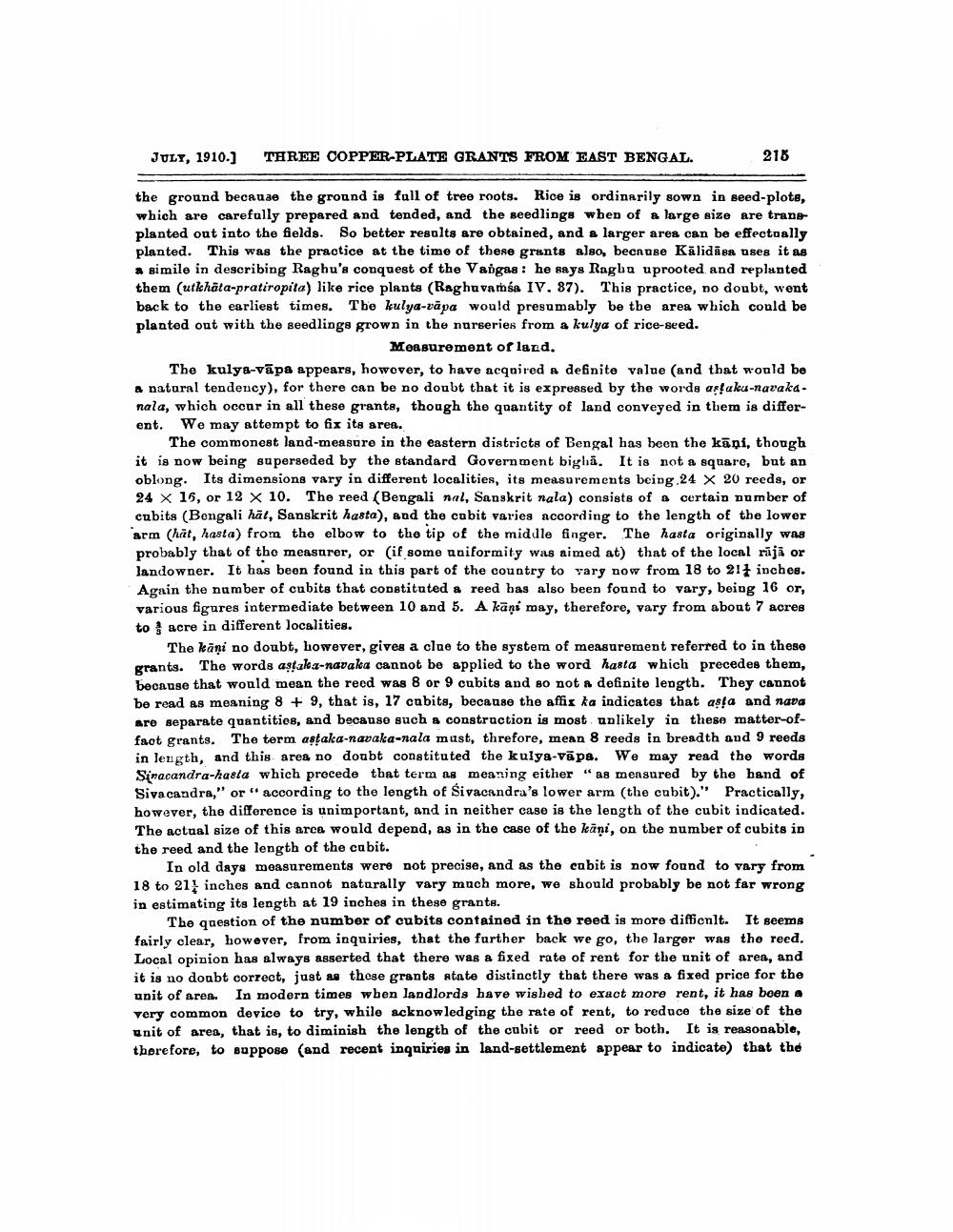________________
JULY, 1910.)
THREE COPPER-PLATE GRANTS FROM EAST BENGAL.
216
the ground because the ground is fall of tree roots. Rice is ordinarily sown in seed-plote, which are carefully prepared and tended, and the seedlings when of a large size are trane planted out into the fields. So better results are obtained, and a larger area can be effectoally planted. This was the practice at the time of these grants also, been use Kālidāsa uses it as a simile in describing Raghu's conquest of the Vangas: he says Raghu uprooted and replanted them (utkhata-pratiropita) like rice plants (Raghuvarśa IV. 87). This practice, no doubt, went back to the earliest times. The kulya-vāpa would presumably be tbe area which could be planted out with the seedlings grown in the nurseries from a kulya of rice-seed.
Measurement of laud. The kulya-vāpa appears, however, to have acquired a definite value (and that would be a natural tendency), for there can be no doubt that it is expressed by the words arlaku-navakanala, which occur in all these grants, though the quantity of land conveyed in them is different. We may attempt to fix its area.
The commonest land-measure in the eastern districts of Bengal has been the kāņi, though it is now being superseded by the standard Government bigha. It is not a square, but an oblong. Its dimensions vary in different localities, its measurements being 24 X 20 reeds, or 24 X 16, or 12 X 10. The reed (Bengali nal, Sanskrit nala) consists of a certain number of cubits (Bengali hal, Sanskrit hasta), and the cabit varies according to the length of the lower arm (hāt, hasta) from the elbow to the tip of the middle finger. The hasta originally was probably that of the measurer, or (if some noiformity was aimed at) that of the local rājā or landowner. It has been found in this part of the country to vary now from 18 to 214 inches. Again the number of cubits that constituted a reed has also been found to vary, being 16 or, various figures intermediate between 10 and 5. A kāņi may, therefore, vary from about 7 acres to acre in different localities.
The kāņi no doubt, however, gives a clue to the system of measurement referred to in these grants. The words astaka-navaka cannot be applied to the word hasta which precedes them, because that would mean the reed was 8 or 9 cubits and do not a definite length. They cannot be read as meaning 8 + 9, that is, 17 cubits, because the affis ka indicates that asta and nava are separate quantities, and because such a construction is most unlikely in these matter-offact grants. The term astaka-navaka-nala must, threfore, mean 8 reeds in breadth and 9 reeds in length, and this area no doubt constituted the kulya-vāpa. We may read the words Sinacandra-hasla which precede that term as meaning either was measured by the hand of Siva candra," or "according to the length of Sivacandra's lower arm (the cubit)." Practically, however, the difference is unimportant, and in neither case is the length of the cubit indicated.
The actual size of this area would depend, as in the case of the käni, on the number of cubits in the reed and the length of the cabit.
In old days measurements were not precise, and as the cabit is now found to vary from 18 to 21 inches and cannot naturally vary much more, we should probably be not far wrong in estimating its length at 19 inches in these grants.
The question of the number of cubits contained in the reed is more difficnlt. It seems fairly clear, however, from inquiries, that the farther back we go, the larger was the reed. Local opinion has always asserted that there was a fixed rate of rent for the unit of area, and it is no doubt correct, just as those grants state distinctly that there was a fixed price for the unit of area. In modern times when landlords have wished to exact more rent, it has been a very common device to try, while acknowledging the rate of rent, to reduce the size of the unit of area, that is, to diminish the length of the cubit or reed or both. It is reasonable, therefore, to suppose (and recent inquiries in land-settlement appear to indicate) that the




